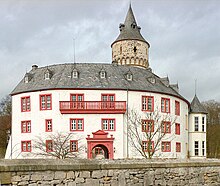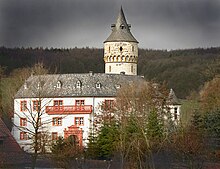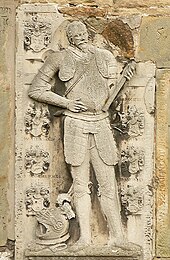Oelber Castle

Schloss Oelber is a castle that is located in Oelber on the white road as a district of the municipality of Baddeckestedt in the district of Wolfenbüttel in Lower Saxony . The castle is located on the western foothills of the Lichtenberge, which form the northwestern part of the Salzgitter ridge .
The circular complex is a comprehensive renovation from around 1580 on the foundation walls of a moated castle from the 12th century. Almost from the beginning it was owned by the von Cramm noble family , who shared ownership with another noble family until they died out in 1686. Because of its picturesque appearance, the palace complex was used in 1960 for outdoor recordings of the movie The Haunted Castle in the Spessart .
history

The former moated castle Oelber only played a subordinate role in the Middle Ages . In a valley of the Lichtenberg ridge , away from the major military and trade routes , it was not contested. However, since it belonged to the Principality of Braunschweig-Wolfenbüttel from 1523, the location had a sensitive location in the extreme south-western tip of the heartland. Surrounded by foreign territories, the Brunswick dukes kept it in their possession through all the turmoil. During the Thirty Years' War , the imperial general, Count Tilly, quartered with his troops for three months in the complex, which has now become a castle . One room still bears the name “Tilly-Saal” today. After his departure, the Danish army under Count Philipp Reinhard von Solms took the castle and devastated it as well as the village. Tilly's troops placed the Danes under King Christian IV on the white road about 15 km south of Oelber and defeated them on August 27, 1626 in the battle of Lutter am Barenberge .
Feudal history
In the sense of feudal system , the bishops of the Hildesheim diocese initially had sovereignty over the castle and the village. After the Hildesheim collegiate feud , the Principality of Braunschweig-Wolfenbüttel became the new feudal lender for the lords of the castle in 1543.
Building history


Today's palace complex stands on the foundations of a medieval moated castle and appears in a historical description as follows:
- The noble castle Oelber is ... a pretty handsome, but almost old building, built by the noble noble family, the von Cramm family. This castle ... is built in a circul round, surrounded by a moat.
Around 1580 extensive renovations were carried out, which amounted to a new building. The then lord of the castle and landgrave Hessian governor of the land on the Lahn in Marburg , Burchard VI. von Cramm , transformed the mighty, almost closed structure with inner courtyard into a Renaissance castle . The model was the Marburg Castle. The surrounding moat was drained and filled. One tradition says:
- In 1583 Burchard von Kram ... along with his brother Frantz von Kram, as it were, rebuilt the Oelber Castle and decorated it in various ways.
Further renovations were made in the 19th century when the east wing was redesigned. Also it increased the circular stair tower in the courtyard to the impression of the keep to awaken. A larger park was created to the east.
The castle has a small inner courtyard, which is surrounded by mainly three-story buildings, some of which are half-timbered . In a small area there is a vacant lot that is filled with a wall. The access is a gate passage on the south side, which has a barrel vault with Renaissance beams. In addition to the actual castle, the upper castle, there is also a spatially separated outer castle and dated 1594 . It is a simple, two-story rectangular building in the Renaissance style .
Ownership
The history of ownership of the castle and the associated manor began in 1274 with the sale by the noble lords of Meinersen to the von Krebs family. Documents from 1296 and 1299 indicate that the knight dynasty of the "von Cramm" family became owners. Ludolf and Burghard von Cramm are named as Burgmannen. The Lords of Cramm had to share the castle and the estate with other noble families for centuries. In 1390 the "von Steinberg" are named as co-owners, shortly afterwards the gentlemen "von Bortfeld" took their place. Within the families, the rights were again divided, which led to difficult ownership conditions internally with a division into an upper and lower courtyard (main castle and outer bailey). The castle therefore had four knight seats until the 18th century. When the von Bortfeld family died out in 1686, the situation did not get any easier, as a dispute over property broke out within the von Cramm family. The family was officially sole owner only in 1766 and in 1771 the ownership structure was finally settled. The finance manager Egbert Freiherr von Cramm has been the lord of the castle since 1974.
Since the castle is privately owned, it is not open to the public, except on special occasions.
Noble family von Cramm
The von Cramm family already appears in documents from the 12th century, their origin is believed to be in the nearby village of Cramme in today's Wolfenbüttel district . She was a wealthy knight family and a respected feudal taker to the clerical and secular lords of the region of today's southeast Lower Saxony. In the Middle Ages many descendants were knights or squires , but also ministerials . In later centuries family members served the Guelph dukes as generals, chamberlains and ministers.
Worth mentioning are:
- Ashwin IV, a 16th century mercenary leader who served both French kings and Lüneburg dukes in European theaters of war.
- Gottfried von Cramm , the tennis baron , (1909-1976) became world famous as a tennis player, he was three times in the final of the tennis tournament in Wimbledon . He was buried in Oelber on the white road near the palace chapel after his fatal car accident in Egypt.
Castle and village
In its history, the village of Oelber was closely connected to the castle and its masters. The economic basis of the noble owners was large estates in the form of a manor . The land and large herds of livestock gave the villagers wages and bread. Ancillary businesses were also set up, such as a distillery , a brewery , a brickworks and a lime works.
Todays use
After Egbert von Cramm took over the palace complex in 1974, he had the traditional property extensively renovated. His wife Helena, née Countess Wolff-Metternich , made the castle a magnet for the entire region. Together with Anna von Veltheim , née Countess zu Rantzau , she founded an event company that organizes events such as exhibitions, music concerts, art and antique fairs and Christmas markets in the palace complex and in the manor buildings that have also been restored. A special attraction for many visitors were the jousting games held in summer in previous years .
Castle as a film set

In 1960, director Kurt Hoffmann shot exterior shots for the film The Spooky Castle in Spessart with Liselotte Pulver in front of the picturesque backdrop of the palace . The action takes place in today's wooded Spessart , when ghosts haunt the castle, which were walled in as robbers centuries ago . The impoverished castle owner does justice to the spook , as the walls are to be bought up and converted into a luxury hotel. The film tried to build on the hit movie Das Wirtshaus im Spessart from 1958.
literature
- Community of Oelber aw W. (Ed.): 800 years of Oelber aw ways . Festschrift for the anniversary celebrations in June 1963, Braunschweig 1963
- Hans Adolf Schultz : Burgen und Schlösser des Braunschweiger Land , Braunschweig 1980, The castle Oelber on the white road , pp. 140-141, ISBN 3-878840128
- Margret Zimmermann, Hans Kensche: Castles and palaces in Hildesheimer Land . Hildesheim, 2001, pp. 123-124
- Gesine Schwarz: The knight seats of the old country of Braunschweig. Göttingen 2008, pp. 179-188.
Web links
- Entry by Gudrun Pischke zu Oelber in the scientific database " EBIDAT " of the European Castle Institute
- Oelber Castle in the Braunschweig-Ostfalen region
- Oelber Castle on Braunschweig tours
- Official website of the castle and the "Oelber Event" event service
- Description of the Ritterspiele Schloss Oelber ( Memento from September 7, 2010 in the Internet Archive )
- Description of the film The Haunted Castle in the Spessart ( Memento from December 26, 2007 in the Internet Archive )
- Description at burgenwelt.de
- Description and photos of the shooting at burgerbe-Blog.de
- Historical reconstruction drawing
- Description of the landscape park of Schloss Oelber at the Lower Saxony Society for the Preservation of Historic Gardens
Coordinates: 52 ° 6 ′ 6 ″ N , 10 ° 14 ′ 16 ″ E
